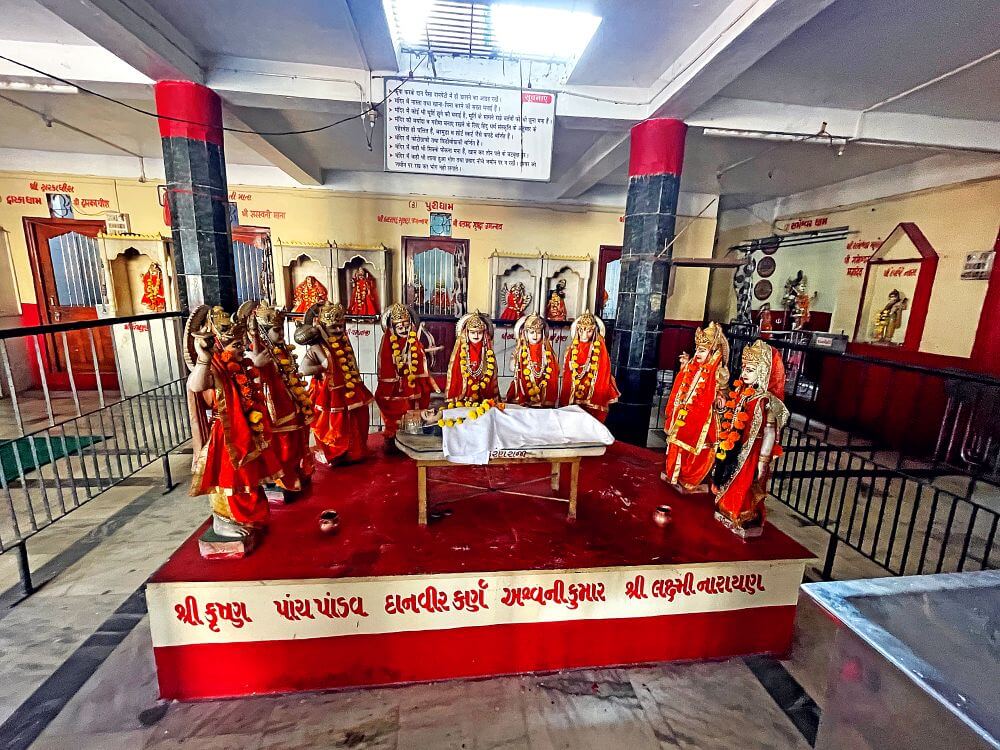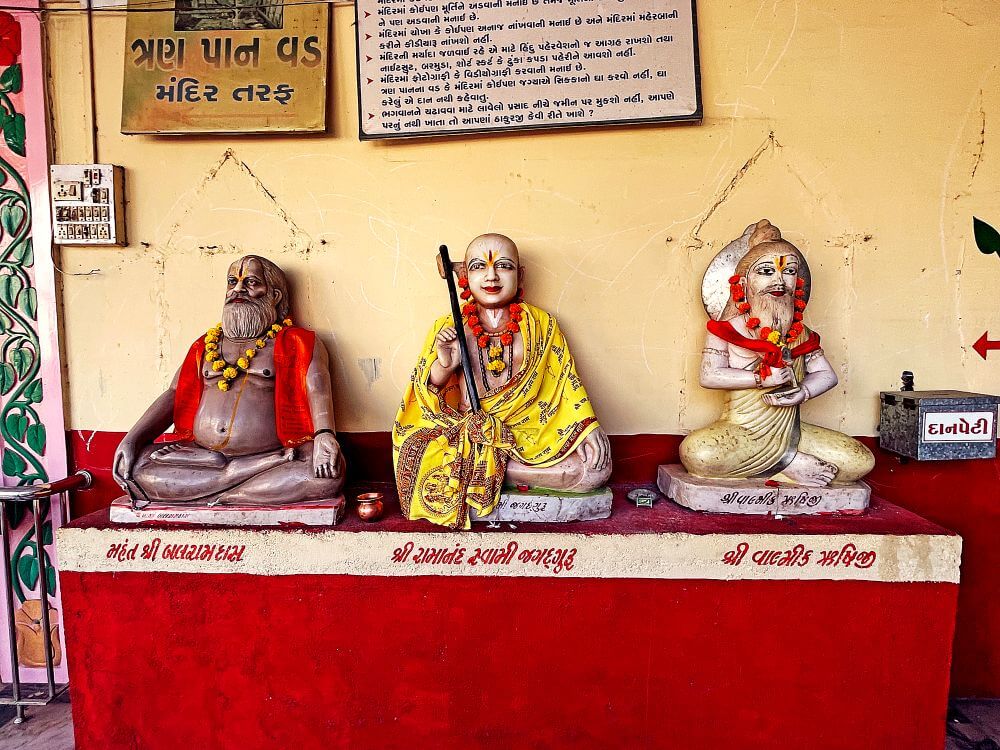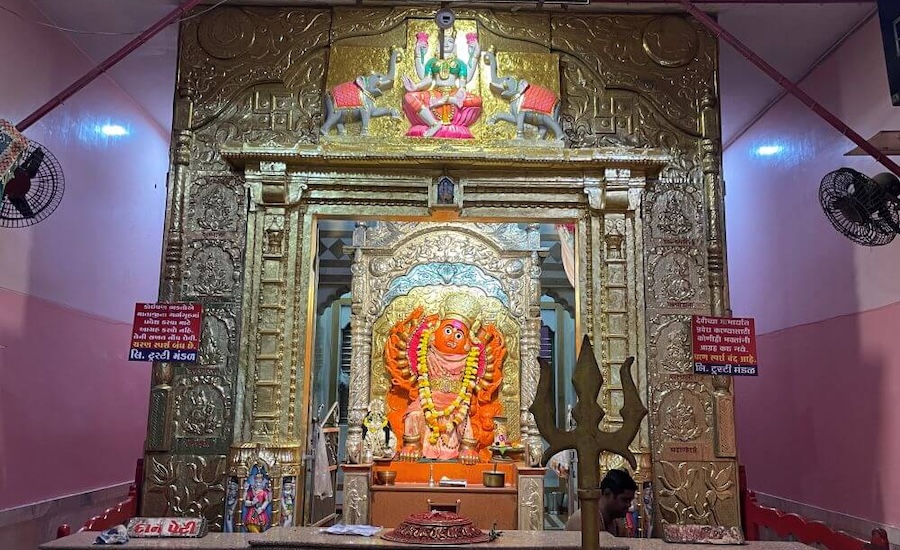
 Two significant sites associated with the legendary Karna, a key figure from the Mahabharata, are located within approximately 1.25 kilometers of each other in Surat, Gujarat. One of these is the ‘Panch Pandav Ovaro’ in the village of Phulpada, and the other is the Char Dham Temple in Anandnagar, which houses the revered Three-Leaf Banyan Tree (Tran Pan no Wad). According to local lore, this is the sacred ground where Karna was cremated, with Lord Krishna and the Pandavas said to have been present, making the site deeply revered. Every day, hundreds of devotees visit this holy spot to witness the Three-Leaf Banyan Tree.
Two significant sites associated with the legendary Karna, a key figure from the Mahabharata, are located within approximately 1.25 kilometers of each other in Surat, Gujarat. One of these is the ‘Panch Pandav Ovaro’ in the village of Phulpada, and the other is the Char Dham Temple in Anandnagar, which houses the revered Three-Leaf Banyan Tree (Tran Pan no Wad). According to local lore, this is the sacred ground where Karna was cremated, with Lord Krishna and the Pandavas said to have been present, making the site deeply revered. Every day, hundreds of devotees visit this holy spot to witness the Three-Leaf Banyan Tree.
According to the Tapi Purana and other mythological legends, the generous warrior Karna expressed a wish to be cremated on Kunvar Bhumi—a virgin land where no cremation had ever taken place. Lord Krishna searched extensively and found such a site on the banks of the Tapi River, where the Char Dham Temple stands today. Karna’s last rites were performed there by Krishna and the Pandavas. Another legend recounts that the Pandavas later offered tarpan (ritual offerings for the dead) at the Panch Pandav Ovaro site.
Lord Krishna searched extensively and found such a site on the banks of the Tapi River, where the Char Dham Temple stands today. Karna’s last rites were performed there by Krishna and the Pandavas. Another legend recounts that the Pandavas later offered tarpan (ritual offerings for the dead) at the Panch Pandav Ovaro site.
In the Mahabharata, authored by Sage Ved Vyasa, the Stri Parva (Chapter 27) describes the following:
‘Tat anayayamasa karnasya saparichchhadah।। Striyah kurupatirdhiman bhratuh premna Yudhishthirah। Sa tabhih saha dharmatma pretakrutya manantaram।। Chakar vidhivad dhiman dharmarajo Yudhishthirah।।’
It means: Then the wise King Yudhishthira of the Kuru dynasty, out of his deep love for his brother, summoned Karna’s wives along with his attendants. Accompanied by them, the righteous Dharmaraja Yudhishthira dutifully and according to prescribed rituals performed Karna’s last rites. In the Mahabharata’s Shanti Parva, specifically in the Rajadharmanushasana Parva, it is stated: ‘Tato Yudhishthiko raja jñatinam ye hata yudhi। Shraddhani karayamasa tesham prithagudaradhih।।’ This translates to: Then King Yudhishthira, with great generosity and a noble heart, performed shraddha (rituals for the deceased) separately for those of his kin who had been killed in the war. This includes Karna, highlighting Yudhishthira’s sense of duty and reverence for his kin, even in the aftermath of the devastating war. According to the Mahabharata, these rituals were conducted on the banks of the Ganga River. However, local folklore attributes this event to the banks of the Tapi River.
even in the aftermath of the devastating war. According to the Mahabharata, these rituals were conducted on the banks of the Ganga River. However, local folklore attributes this event to the banks of the Tapi River.
Legend further suggests that the land where Karna’s cremation took place was identified as Kumari Bhumi—virgin land where no prior cremation had occurred. To mark its sanctity for future generations, Lord Krishna declared that a banyan tree with three leaves would grow there. Today, a three-leafed banyan sapling is preserved at the site, believed to be a testament to this mythological event.
Located on a bustling road in Anandnagar, the Char Dham Temple has a simple yet elegant entrance. Inside, a cowshed (gaushala) is located on the left, while a towering nine-foot idol of Hanuman stands to the right in a tin-roofed shelter. This unique idol depicts Hanuman holding Mount Kailash instead of the usual Dronagiri mountain. A meditating Shiva statue is also seen atop the mountain. At this site, there is also a platform (chowthara) where several idols of Lord Hanuman, coated with shendur (a sacred red vermilion paste commonly used in Hindu rituals), are enshrined.
Inside, a cowshed (gaushala) is located on the left, while a towering nine-foot idol of Hanuman stands to the right in a tin-roofed shelter. This unique idol depicts Hanuman holding Mount Kailash instead of the usual Dronagiri mountain. A meditating Shiva statue is also seen atop the mountain. At this site, there is also a platform (chowthara) where several idols of Lord Hanuman, coated with shendur (a sacred red vermilion paste commonly used in Hindu rituals), are enshrined.
Proceeding further, the entrance to the Char Dham Temple is flanked by small elephant statues symbolising prosperity. Within the spacious main hall lies the Ram Mandir, featuring marble idols of Ram, Lakshman, and Sita seated on a raised marble pedestal. Adjacent to this is a shrine housing Hanuman’s idol. Along the outer walls of the temple are marble statues of prominent spiritual figures, including Mahant Balramdas, Jagadguru Ramanand Swami, and Sage Valmiki.
Along the outer walls of the temple are marble statues of prominent spiritual figures, including Mahant Balramdas, Jagadguru Ramanand Swami, and Sage Valmiki.
The temple’s sanctum houses multiple deities, including Surya Dev (Sun God), Badrinarayan, Kali Mata, Trimukhi Dattatreya, Saraswati, Balabhadra-Subhadra-Jagannath, Saptashrungi Mata, Lord Krishna (Bansidhar), Bhavani Mata, Ganesha, Shiva, Yamuna, and Ganga. A special display in the central hall depicts the cremation of Karna, featuring a lifelike arrangement of his body surrounded by Krishna, the Pandavas, the Ashwini Kumaras, and other divine figures.
A short distance from the main temple lies the sacred banyan tree, believed to be thousands of years old. Marble walls with ornate windows enclose the tree, and a fenced area protects the three-leafed sapling said to mark Karna’s cremation site. Beyond the enclosure, the scenic Tapi River flows, adding to the site’s tranquil atmosphere.
Devotees believe that visiting the Char Dham Temple and the Three-Leaf Banyan Tree fulfills their desires and brings spiritual solace. The temple also offers opportunities to feed cows at the gaushala, which is considered an auspicious act. The temple is open for darshan from 6:00 AM to 12:00 PM and 4:00 PM to 8:00 PM.



